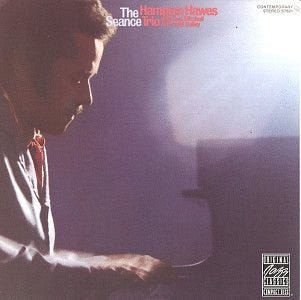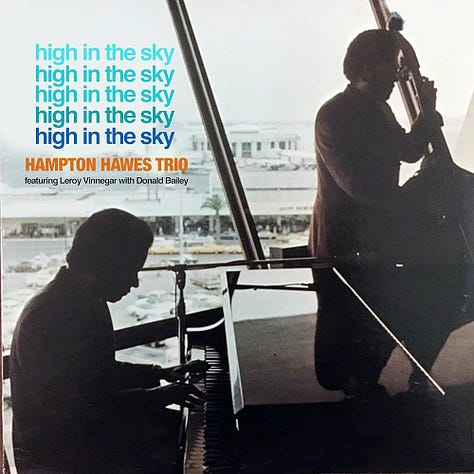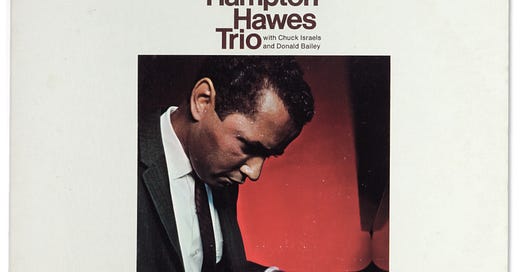By 1963, drummer Donald Bailey had been with organist Jimmy Smith for a decade. Newly signed to Verve Records after years with Blue Note, Jimmy Smith now had at least two Verve singles on the pop charts,1 which made Smith that rarest of things: a famous jazz instrumentalist.
It’s telling that Donald Bailey, 30 years old in March of ‘63, chose this moment to plot a new course. Bailey left Jimmy Smith’s group that summer2, then appeared with the John Coltrane Quartet in Montreal. This was rarefied air, a sign of Donald’s specialness. Bailey was now, along with Roy Haynes, one of only two drummers to sub for Elvin Jones with John Coltrane.
In August 1963, the legendary pianist Hampton Hawes, freed from a prison term on drug charges by a pardon from President Kennedy, was back home in Los Angeles and re-launching his career. Hawes had been the premier bebop pianist on the West Coast, maybe in the USA (Bud Powell was in Europe, after all). Now the music was changing, and Hawes wanted to change with it.
Donald Bailey made his first recording outside Smith’s aegis— George Braith’s Two Souls In One, on Blue Note— in September ‘63, and before the year’s end, moved to Los Angeles. Best to let Hampton Hawes narrate the story himself:
Donald, to me, is the most underrated drummer today, and long overdue for recognition…
I first heard Donald Bailey in 1956 in Pittsburgh. Red Mitchell was with me that day, so we both heard him together. Donald was playing a matinee with Jimmy Smith. We had heard a lot of talk about Jimmy Smith’s group…and wow! were they beautiful…
It was then I made up my mind I would use Donald in my trio and record with him if possible…
About eight years passed before Donald moved to Los Angeles, and when I got the news both Harold Land and I went looking for him. Since then he has made two recordings with me [Here and Now and The Seance] and recorded also with Harold. We still work together, but only occasionally, as he is in demand now; but if I ever organize another trio, I will go looking for him again.
—Hampton Hawes, October 17th, 1969, liner notes to The Seance.
Hawes tapped Bailey for three diverse and far-reaching trio albums3: Here and Now (1965), The Seance (1967) and High In The Sky (1970), each one fresh, inspired, and a lot of fun, with some of the most inventive drumming I’ve ever heard.
Donald Bailey and Hampton Hawes are one of the magic pairings in the music. Taken together, the Hawes-Bailey records explain the twinkling eyes and knowing grins from the folks who knew Donald, who witnessed Bailey’s boundless creativity and fearlessness, his sensitivity, musicianship, and mastery.
Records never tell the whole story, but the Hampton Hawes albums capture an essential part of Donald Bailey. The more I listen, the more clearly I hear Bailey’s total originality and singular perspective. He invented, from whole cloth, his own way to play. No one’s ever sounded like Donald Bailey. It’s some of the bravest music I’ve ever heard.



The first Hampton Hawes date with Donald Bailey is Here and Now (released on Contemporary, recorded May 1965, YouTube link above), with bassist Chuck Israels. A general Bill Evans vibe comes through, enhanced by the presence of Bill’s former bass player Chuck Israels4 .
But there’s no Bill Evans record as boisterous as Here and Now. On the program of then-current pop tunes, Bailey pushes Hawes to new territory. As Hawes said, “I like that searching feeling, I like to go way out, trying to grab it, instead of playing it safe…Why not open up the time and allow for more interplay in the rhythm section?” Donald Bailey, true to himself all the way, was the perfect drummer for Hampton Hawes in 1965.
“Fly Me To The Moon” tells the whole story right away. The brisk 3/4 gradually becomes a whirling dervish, Hawes pushing and pushing, and Donald playing some wild stuff— round-the-kit fills, loud and bass drum and hi-hat counterpoint, and continuous sighs from his low-pitched Chinese cymbal. What a beginning.
Hawes and Israels nod towards Bill Evans on the melody of “What Kind Of Fool Am I”, but it goes somewhere else when Donald rattles off a few hi-hat/snare drum triplets. Bailey and Israels swing out for Hawes’s second chorus, letting us savor Donald’s unadorned cymbal beat, with his surreal bass drum keeping us from getting too comfy.
The trio plays “The Girl From Ipanema” in an irreverent medium-up 4/4, Bailey energized and intense, followed by Hawes’s waltz “Rhonda”, put in another place by Donald’s four-way counterpoint, tom toms, and Chinese cymbal.
Donald takes Henry Mancini’s “Dear Heart” to a similarly new place; the loud rolls on the snare drum at 2:35 always catch me off-guard. Likewise, Barbra Streisand’s signature song, “People”, really takes off when Bailey unfurls his thick swinging tapestry.
Hawes solos in a McCoy-like fast 4/4 on “Chim Chim Cher-ee”. Donald’s right at home, pushing Hawes along then opening up with an out-of-time drum solo, revealing a previously-unknown side of Donald, one we’re lucky was recorded; there’s certainly no Jimmy Smith track with an impressionistic Donald Bailey solo.
Here and Now closes with a second Mancini melody, “The Days Of Wine And Roses”, and Bailey’s invention hasn’t flagged. He just keeps going, signaling to his bandmates that this is a creative enterprise, taking Hawes and Israels to a new place.
A year later, Hawes and Bailey, now joined by bassist Red Mitchell, were in the midst of a 9-month residency at Mitchell’s Studio Club5 in Los Angeles. Contemporary Records captured a few sets, and released six takes as The Seance in 1969 (YouTube link above) with a great liner essay from Hawes.
Unlike Here and Now, The Seance is standard repertoire: blues, rhythm changes, and show tunes. Red Mitchell, one of Hawes’s closest collaborators6, fits right in to the Hawes-Bailey axis. On that session, Bailey was the wild card. On (parts of ) The Seance, he’s a kaleidoscope, always changing: broken time becomes straight 4/4, which then becomes polyrhythmic, et cetera; perfect for Red Mitchell and Hampton Hawes.
Hawes launches into the title track, a medium blues with no specific melody. Hamp just plays his little call, and the trio’s off, hushed and intense, seance-like, the air thick with possibility: anything can happen. Bailey starts with some polite brushes and a few gentle taps, but finishes Mitchell’s solo with a loud and proud double-time samba, sounding like a complete percussion section. It’s gonna be a wild night.
The trio goes all-in on an uptempo “Oleo”, with lots of lovely details from Bailey— riding on half-open hi-hats, surreal counterpoint on the bass drum, a chattering left hand. The trio’s barely staying inside the lines, so it’s a relief when it spills into an open drum solo, something that would never happen if Barry Harris was playing “Oleo”. Bailey’s solo is great, free associating some stretched bebop, hinting at but not really playing the form, his phrases singing out from his beautifully-tuned kit. Don’t overlook Bailey’s chops; there’s some serious snare drum work here.
“Easy Street”, relaxed and to-the-point, finds Bailey on the money, playing Hamp’s arrangement. Donald’s reminding us that his chattering feet, wandering left hand, and blurred bebop are choices. He can play any way he wants.
On Side 2, we get an up-tempo blues, “Suddenly I Thought Of You”, with Bailey’s polyrhythmic rub enabling the trio to halve and then double the tempo. On “For Heaven’s Sake”, Bailey eschews brushes on the snare for emotive cymbal caresses and tom rolls. For Donald, everything’s a choice.
Bailey starts “My Romance” with brushes; when the sticks come out, he elevates everything with the bravery and delicacy of his counterpoint. Hawes and Bailey’s first 16 after Mitchell’s solo is a magic near-traffic jam; they tussle for a few more choruses before touching down and bringing the album to a close.
Hampton Hawes, Red Mitchell, and Donald Bailey, casually playing blues, rhythm changes, and old show tunes, have created their own new world. Jazz is the best.
Here and Now is an adventurous take on Sixties pop, The Seance is a gig for the ages, but High In The Sky, featuring Bailey, bassist Leroy Vinnegar, and five Hawes originals, is the most ambitious and fully-conceived album of the three. Recorded in 1970 for Vault Records and now streaming everywhere, High In The Sky is the culmination of Hawes and Bailey’s collaboration.
I’d never heard of High In The Sky. But it’s the first record Larry Grenadier mentioned to me in our conversation about Donald, and the one title that Kenny Wollesen exclaimed when I told him I was writing about Donald Bailey7. Thank you Kenny Wollesen and Larry Grenadier— this is some of the most adventurous drumming I’ve ever heard. As Ethan Iverson writes, it was Donald’s willingness to take a risk that set him apart. That’s captured in a distilled essence on High In The Sky.
It took a while to get it. Basically, Bailey takes his contrary counterpoint of Here and Now and bebop kaleidoscope of The Seance to their logical extreme. On High In The Sky, he (sort of) keeps time with his right hand, while his left hand and feet freely drift in and out of time (sometimes). More to the point, Donald Bailey, who left the commercial juggernaut of Jimmy Smith to go his own way, is now an experimental artist, working at the edge of the possible. This is the sound of a bravery, made at great sacrifice.
The record opens with the only non-Hawes composition, Burt Bacharach’s “The Look of Love”, here a moody and serious samba. Hampton solos over a D minor vamp while Bailey plays dense, transparent counterpoint, at once enmeshed in Vinegar’s hypnotic bass line (and overdubbed tambourine) and scattering off into near-rubato. Bailey’s resonant bass drum on this track haunts me; sometimes it’s all I can hear, and it’s a complete musical statement.
Hawes makes his Tyner/Coltrane connection explicit on “Evening Trane”, with Bailey coloring outside the lines with all four limbs, at times really sounding like Sunny Murray and Rashied Ali. That Bailey can make Murray and Ali vocabulary work with Hampton Hawes and Leroy Vinnegar on a swinging 16-bar form shows how correct Bailey was.
“Muffin Man” is a Donald Bailey tour-de-force. After the 20-bar theme concludes, the trio hovers on Vinegar’s F minor vamp8 with Bailey shuffling like a shekere on his ride cymbal. Gradually, the coughs and comments from his feet and left hand become eruptions, threatening to override the time but never doing so.
The first time I heard “Muffin Man”, I wondered if Bailey recorded the cymbal, then overdubbed the rest, so disconnected and two-worlds is the drumming. Is that what’s happening? Sometimes I think so, then I revisit and am not so sure9. Regardless of how it was done, I know of no drumming like this. Bravo Donald Bailey!
The title track is a close second to “Muffin Man” for all-time Donald Bailey performance. An 8-bar form in D dorian, “High In The Sky” briefly swings out (what a joy to hear Bailey and Leroy Vinnegar mix it up), without Bailey ever abandoning his surreality. This is exactly the way we play now, asserting other realities and our drummerly independence. Donald Bailey was there in 1970.
The last two tracks, “Carmel”, a gorgeous ballad, and the Latin-flavored “Spanish Girl”, with Bailey playing tambourine, cowbell, bass drum, and hi hat (something seems overdubbed here), feature cycling forms and chord changes instead of modal vamps and open blowing, bringing the Hawes-Bailey cycle to a gentle and satisfying close.
But the older procedure sounds newly fresh and alive, because Bailey had been pushing so hard against it for the rest of the album. We know this now; everybody plays free once in a while. But Donald Bailey got there in 1970, way ahead of schedule, following his own star.
Larry Grenadier said it best— for Donald, every situation was a chance to create. Certainly, not every drummer would see the Jimmy Smith gig as a chance to innovate and play expressively. With Hampton Hawes, Bailey was invited to go even further, which he did, for us.
I feel this more and more these days, playing and going to gigs— no matter the attitude of the performer or the social setting, we’re being given something bring us some variety of joy. Donald Bailey took risks, in music and life, and shared the results with us, to make our lives better.
Examples of bravery and courage, never common, are in ever-shorter supply today. I’ve been listening closely to these records for over nearly two months, and it’s Donald’s bravery that I keep marveling over. These three jazz piano trio releases from the great Hampton Hawes, made decades ago on tight budgets and known to only a few, are as pure examples of bravery as I’ll ever hear.
There’s no real end to essays like this. We just keep listening and learning, forever and ever. It’s enough to build a life around.
More soon and many thanks…
Smith’s two hits were, as far as I can tell, “Walk On The Wild Side” and “Hobo Flats”, neither featuring Donald Bailey. Ed Shaugnessy is on “Walk On The Wild Side”, and I’m not sure who’s playing drumset on “Hobo Flats”.
Smith replaced Donald Bailey with Billy Hart.
Actually, four albums— I’m All Smiles, from the same gig as The Seance, was brought out by Contemporary in 1973, years after Hawes and Bailey had moved on. It’s good, but it’s inessential to our story.
Donald Bailey at times really feels parallel to Paul Motian. Like Motian, Donald gives his imagination and individuality free rein while still playing ‘sounds-like-jazz’ drums (though he’s unrestrained with Hawes in a way Motian never was with Bill Evans). But the Bailey/Motian connection is so intriguing— both born in Philadelphia (Motian’s family moved Providence, RI soon after his birth, which is where Paul was raised), they nearly share a birthday (Paul 3/25/31, Donald 3/26/33). This is the best summary I can manage: Paul Motian played free music with the rigor and intentionality of a bebopper, while Donald Bailey played bebop drums with the surreality and spirit of a free improviser. Respect.
I’d always thought it was Red Mitchell’s club, but it’s not. Red Mitchell had nothing to do with the place at all.
Mitchell was the bassist in the ‘original’ Hampton Hawes trio with drummer Chuck Thompson, captured on the Contemporary releases from 1955. These are Hawes records that Charlie Haden heard, the ones that pushed him to move to Los Angeles in 1957 to become a jazz musician. Psychic energy radiates around Hampton Hawes, Red Mitchell, and Donald Bailey, obscure as the names are today.
Kenny seldom mentions specific records to me, but he was effusive and enthusiastic about Donald on High In The Sky, saying Donald reminded him of Jack DeJohnette, Al Foster, and all the cats, like Donald was anticipating the way we’d all play.
A bass line which Vinegar barely alters for the entire tune, despite the chaos Bailey unleashes! Leroy Vinegar sounds so incredible here, I need to learn much more about him.
Readers, anyone have any intel on this?




Great!!! FWIW "Muffin Man" is my favorite Hawes solo in a modal context. I keep meaning to transcribe it--maybe this post will push me there!
Thanks so much for this great piece on the mighty Donald Bailey. You might also check out his drumming and harmonica playing on the killer Harold Land side "The Peace Maker" on Cadet, and his drumming on "Trio" a 1989 side on Capri with Jimmy Rowles and Red Mitchell, and "Moment to Moment", a 1998 DIW side by bassist Greg Cohen with Teddy Edwards and Gerry Wiggins.